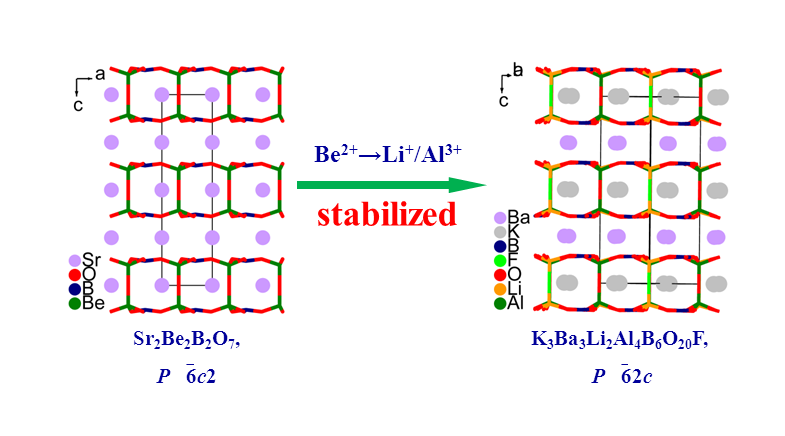|
Deep-ultraviolet (deep-UV, wavelength below 200 nm) coherent light plays an important role in a number of advanced scientific instruments. KBe2BO3F2(KBBF) is the benchmark deep-UV NLO material, but it contains highly toxic beryllium and suffers a strong layering tendency, hindering its commercial applications.
Recent studies led by Prof. LUO Junhua and ZHAO Sangen from Fujian Institute of Research on the Structure of Matter, Chinese Academy of Sciences obtained a new beryllium-freedeep-UVNLO material,K3Ba3Li2Al4B6O20F(KBLABF), by the substitution of toxic Be for Al & Li elements.KBLABFpreserves the double-layered structure of the notableSr2Be2B2O7(Nature,373, 322,1995).
In the structure of KBLABF, the[Li2Al4B6O20F]∞double-layersmaintains the favorable arrangement of the NLO-active[BO3]3-groups in the structures of KBBF andSr2Be2B2O7, thereby preserving the desirable optical propeties of the latter:adeep-UVtransparent window, a powder SHG response (1.5 × KDP) comparable to that of KBBF, and phase-matchability.Furthermore,the[Li2Al4B6O20F]∞double-layersare tightly bridged viaBa―O bonds.
As a result, KBLABF exhibits no layering growth tendency, which is confirmed by the as-grown KBLABF single crystal with athickness of about 8 mm in thecdirection. More importantly,KBLABFeliminates the structural instability ofSr2Be2B2O7, which is confirmed by the small structuralconverge factor,obtainment of large-sizedKBLABFsingle crytal, andphonon dispersioncalculations (byco-authorsProf. LIN Zheshuai et al from Technical Institute of Physics and Chemistry, Chinese Academy of Sciences).
These attributes makeKBLABFan attractive candidate for the next-generation deep-UV NLO materials. Moreover, the substitution of Be for Al&Li in beryllium borates provides a new opportunity to design beryllium-free deep-UV NLO materials with good performance.
The study entitled “Designing a Beryllium-Free Deep-Ultraviolet Nonlinear Optical Material without a Structural Instability Problem” has been published inJ. Am. Chem. Soc.(2016, 138, 2961-2964).

The substitution of Be forAl&LifromSr2Be2B2O7led to aberyllium-freedeep-UVNLO material,K3Ba3Li2Al4B6O20F, without a structural instability problem (Image by Prof. LUO Junhua's group) |